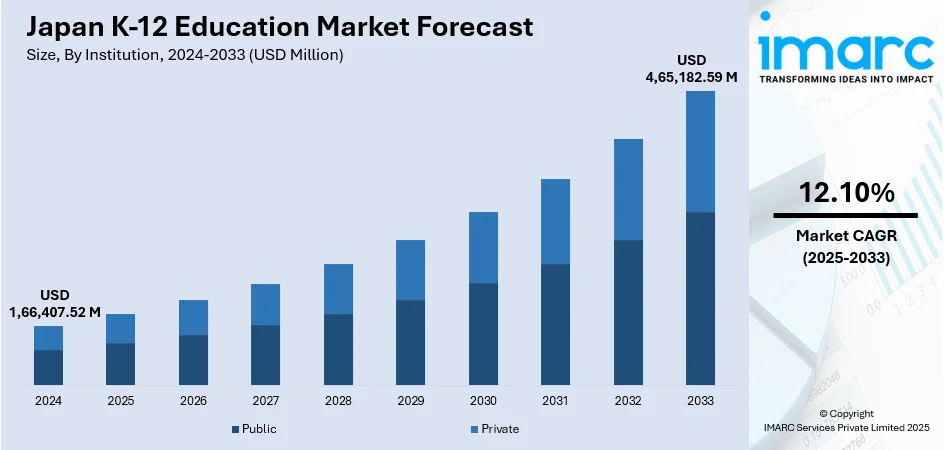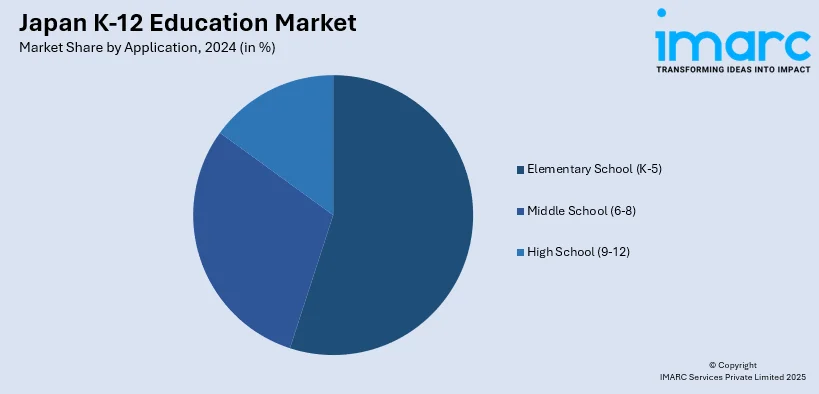
Japan K-12 Education Market Size, Share, Trends and Forecast by Application, Institution, Delivery Mode, and Region, 2025-2033
Japan K-12 Education Market Overview:
The Japan K-12 education market size reached USD 1,66,407.52 Million in 2024. Looking forward, IMARC Group expects the market to reach USD 4,65,182.59 Million by 2033, exhibiting a growth rate (CAGR) of 12.10% during 2025-2033. The market is fueled by the government's move to modernize education facilities, such as the introduction of online learning platforms and distribution of digital devices among students, which has improved the quality and accessibility of education. Growing focus on STEM education is also designed to prepare students with skills required in the changing job landscape. Growth in private and overseas schools, deployment of artificial intelligence and adaptive learning technologies is further individualizing learning and addressing individual students' needs, which is fueling the Japan K-12 education market share.
|
Report Attribute
|
Key Statistics
|
|---|---|
|
Base Year
|
2024
|
|
Forecast Years
|
2025-2033
|
|
Historical Years
|
2019-2024
|
| Market Size in 2024 | USD 1,66,407.52 Million |
| Market Forecast in 2033 | USD 4,65,182.59 Million |
| Market Growth Rate 2025-2033 | 12.10% |
Japan K-12 Education Market Trends:
Integration of Digital Learning Tools
Japan's K-12 education sector is witnessing change with the integration of digital learning tools. The government's initiative, GIGA School Program, seeks to offer every student in compulsory education a digital device that creates a digital learning environment. This is followed by the legal acceptance of digital textbooks, giving schools the flexibility to select from digital and paper mediums. Additionally, the learning experience is becoming more individualized and interactive due to advancements in technologies like artificial intelligence (AI) and virtual reality (VR). For example, AI-based platforms allow for adaptive learning, addressing specific student needs and paces. These advances are enhancing educational attainment and making students future-ready, with digital literacy taking precedence, which further contributes to the Japan K-12 education market growth.

To get more information on this market, Request Sample
Focus on STEM Education
To meet the increased needs for STEM skills, Japan is emphasizing STEM education in the K-12 system more strongly. Programs such as the Super Science High School (SSH) initiative identify some high schools as science and technology centers of excellence, offering students more advanced facilities and research opportunities and chances for collaboration. In addition to receiving increased financing, these institutes are encouraged to establish connections with universities and other higher education establishments. In order to foster creativity and problem-solving skills, the curriculum is also being updated to include more practical exercises like robotics and coding. This emphasis on STEM education is done to prepare students with the abilities they need to succeed in an ever-changing global economy. According to industry reports, in Japan, 35% of students earn a degree in STEM subjects (science, technology, engineering, and mathematics), compared to 38% in the United States, 42% in South Korea and Germany, and 45% in Britain.
Private and International School Growth
The need for international and private schools in Japan's K-12 education sector is increasing, fueled by the rise of the middle class and a growing number of expatriates. Parents are looking for quality educational options that provide varying curricula such as American, British, and International Baccalaureate (IB) programs. In Tokyo and Yokohama, there are many international schools that respond to this need, offering education that meets international standards. The government's Vision 2030 program has also encouraged private sector participation through public-private partnership (PPP) initiatives, such as the construction of new schools in large cities. This expansion is improving the education landscape while also promoting a competitive atmosphere that spurs enhancement in teaching and learning outcomes.
Japan K-12 Education Market Segmentation:
IMARC Group provides an analysis of the key trends in each segment of the market, along with forecasts at the country and regional levels for 2025-2033. Our report has categorized the market based on application, institution, and delivery mode.
Application Insights:

- Elementary School (K-5)
- Middle School (6-8)
- High School (9-12)
The report has provided a detailed breakup and analysis of the market based on the application. This includes elementary school (K-5), middle school (6-8), and high school (9-12).
Institution Insights:
- Public
- Private
A detailed breakup and analysis of the market based on the institution has also been provided in the report. This includes public and private.
Delivery Mode Insights:
- Online
- Offline
A detailed breakup and analysis of the market based on the delivery mode has also been provided in the report. This includes online and offline.
Regional Insights:
- Kanto Region
- Kansai/Kinki Region
- Central /Chubu Region
- Kyushu-Okinawa Region
- Tohoku Region
- Chugoku Region
- Hokkaido Region
- Shikoku Region
The report has also provided a comprehensive analysis of all the major regional markets, which include Kanto Region, Kansai/Kinki Region, Central /Chubu Region, Kyushu-Okinawa Region, Tohoku Region, Chugoku Region, Hokkaido Region, and Shikoku Region.
Competitive Landscape:
The market research report has also provided a comprehensive analysis of the competitive landscape. Competitive analysis such as market structure, key player positioning, top winning strategies, competitive dashboard, and company evaluation quadrant has been covered in the report. Also, detailed profiles of all major companies have been provided.
Japan K-12 Education Market Report Coverage:
| Report Features | Details |
|---|---|
| Base Year of the Analysis | 2024 |
| Historical Period | 2019-2024 |
| Forecast Period | 2025-2033 |
| Units | Million USD |
| Scope of the Report |
Exploration of Historical Trends and Market Outlook, Industry Catalysts and Challenges, Segment-Wise Historical and Future Market Assessment:
|
| Applications Covered | Elementary School (K-5), Middle School (6-8), High School (9-12) |
| Institutions Covered | Public, Private |
| Delivery Modes Covered | Online, Offline |
| Regions Covered | Kanto Region, Kansai/Kinki Region, Central /Chubu Region, Kyushu-Okinawa Region, Tohoku Region, Chugoku Region, Hokkaido Region, Shikoku Region |
| Customization Scope | 10% Free Customization |
| Post-Sale Analyst Support | 10-12 Weeks |
| Delivery Format | PDF and Excel through Email (We can also provide the editable version of the report in PPT/Word format on special request) |
Key Questions Answered in This Report:
- How has the Japan K-12 education market performed so far and how will it perform in the coming years?
- What is the breakup of the Japan K-12 education market on the basis of application?
- What is the breakup of the Japan K-12 education market on the basis of institution?
- What is the breakup of the Japan K-12 education market on the basis of delivery mode?
- What is the breakup of the Japan K-12 education market on the basis of region?
- What are the various stages in the value chain of the Japan K-12 education market?
- What are the key driving factors and challenges in the Japan K-12 education market?
- What is the structure of the Japan K-12 education market and who are the key players?
- What is the degree of competition in the Japan K-12 education market?
Key Benefits for Stakeholders:
- IMARC’s industry report offers a comprehensive quantitative analysis of various market segments, historical and current market trends, market forecasts, and dynamics of the Japan K-12 education market from 2019-2033.
- The research report provides the latest information on the market drivers, challenges, and opportunities in the Japan K-12 education market.
- Porter's five forces analysis assist stakeholders in assessing the impact of new entrants, competitive rivalry, supplier power, buyer power, and the threat of substitution. It helps stakeholders to analyze the level of competition within the Japan K-12 education industry and its attractiveness.
- Competitive landscape allows stakeholders to understand their competitive environment and provides an insight into the current positions of key players in the market.
Need more help?
- Speak to our experienced analysts for insights on the current market scenarios.
- Include additional segments and countries to customize the report as per your requirement.
- Gain an unparalleled competitive advantage in your domain by understanding how to utilize the report and positively impacting your operations and revenue.
- For further assistance, please connect with our analysts.
 Request Customization
Request Customization
 Speak to an Analyst
Speak to an Analyst
 Request Brochure
Request Brochure
 Inquire Before Buying
Inquire Before Buying




.webp)




.webp)












